The Extracorporeal CO2 Removal Devices Market is estimated to be valued at USD 114.9 billion in 2025 and is projected to reach USD 201.9 billion by 2035, registering a compound annual growth rate (CAGR) of 5.8% over the forecast period.
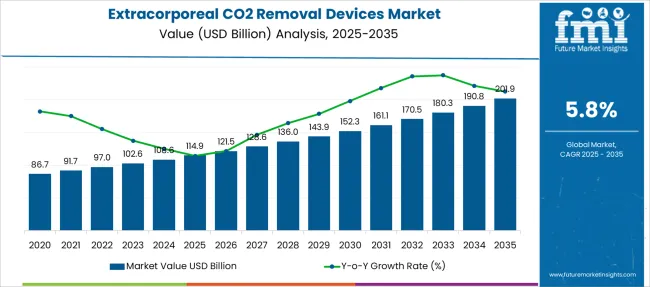
| Metric | Value |
|---|---|
| Extracorporeal CO2 Removal Devices Market Estimated Value in (2025 E) | USD 114.9 billion |
| Extracorporeal CO2 Removal Devices Market Forecast Value in (2035 F) | USD 201.9 billion |
| Forecast CAGR (2025 to 2035) | 5.8% |
The extracorporeal CO2 removal devices market is advancing steadily due to the rising global burden of respiratory failure, increased prevalence of acute pulmonary disorders, and the growing need for minimally invasive respiratory support technologies. Traditional ventilation strategies often come with complications such as barotrauma and oxygen toxicity, prompting the adoption of alternative CO2 removal techniques.
Extracorporeal systems provide efficient CO2 elimination while allowing for lung protective ventilation, which is especially valuable in critical care settings. Clinical emphasis on improving survival rates in intensive care units and expanding extracorporeal life support protocols are further encouraging adoption.
In addition, ongoing advancements in device miniaturization and improved hemocompatibility are widening the scope for safe and effective application. With healthcare systems focusing on reducing ICU stays and improving outcomes for critically ill patients, the market is expected to witness consistent integration into advanced respiratory management practices.
The market is segmented by Product Type, Application Type, and Sample Type and region. By Product Type, the market is divided into Extracorporeal CO2 Machines, Disposables, and Other Product Types. In terms of Application Type, the market is classified into Acute Respiratory Distress Syndrome (ARDS), Chronic Obstructive Pulmonary Disease (COPD), Bridge to Lung Transplant, and Other Applications. Based on Sample Type, the market is segmented into Venovenous and Arteriovenous. Regionally, the market is classified into North America, Latin America, Western Europe, Eastern Europe, Balkan & Baltic Countries, Russia & Belarus, Central Asia, East Asia, South Asia & Pacific, and the Middle East & Africa.
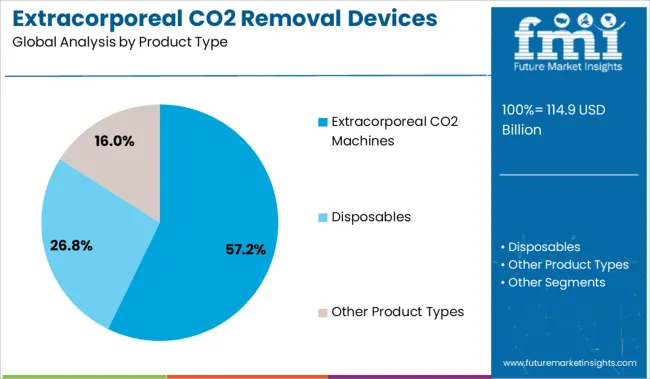
The extracorporeal CO2 machines segment is expected to account for 57.20% of total market revenue by 2025 within the product type category, positioning it as the leading segment. This prominence is supported by their ability to facilitate effective CO2 elimination in patients with compromised lung function, especially when mechanical ventilation alone is insufficient.
These machines offer a safer intervention by reducing ventilator associated lung injury, making them essential in lung protective ventilation strategies. The growing adoption of these systems in intensive care units and their compatibility with existing extracorporeal circuits further supports their expansion.
As hospitals aim to improve outcomes in severe respiratory distress scenarios, the demand for these specialized devices continues to grow, reinforcing their leadership in the product category.
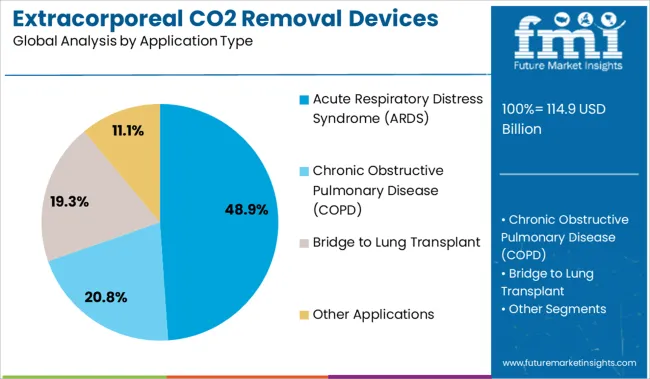
The acute respiratory distress syndrome segment is projected to contribute 48.90% of total market revenue by 2025 under the application type category. This growth is driven by the rising incidence of ARDS due to trauma, pneumonia, sepsis, and more recently viral infections.
The complexity of managing oxygenation and ventilation in ARDS patients without causing additional lung damage has made extracorporeal CO2 removal an increasingly viable option. These devices enable the use of lower ventilator settings, which is critical in preventing further pulmonary injury.
As clinical guidelines continue to evolve toward lung protective strategies, the use of extracorporeal support in ARDS management is expected to see expanded integration across tertiary and critical care settings.
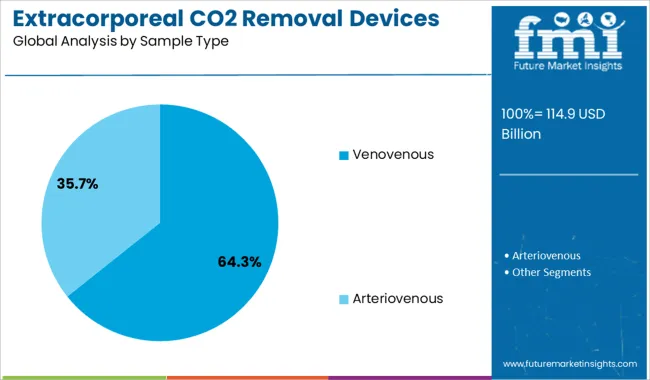
The venovenous sample type segment is anticipated to hold 64.30% of total market revenue by 2025, establishing itself as the dominant segment within this category. This preference is attributed to the minimally invasive nature of venovenous access, which reduces procedure related risks and complications compared to arteriovenous approaches.
The ability to provide sufficient CO2 clearance without requiring arterial cannulation has made it the standard choice in clinical settings, especially for patients with stable hemodynamics. Additionally, improvements in catheter design and flow rate optimization have increased efficiency and safety, promoting broader use.
The favorable risk benefit profile and clinical adaptability of venovenous systems have reinforced their widespread application in extracorporeal CO2 removal therapy.
As per the Extracorporeal CO2 Removal Devices Market industry research by Future Market Insights - a market research and competitive intelligence provider, historically, from 2020 to 2024, market value increased at around 5.6% CAGR, wherein, countries such as Germany, the USA, China, and Japan held a significant share in the global market.
The growing usage of advanced analytics in pharma and medical testing are the key factors influencing the adoption of Extracorporeal CO2 Removal Devices. Owing to this, the market is projected to grow at a CAGR of 5.8% over the coming 10 years.
Health systems and Extracorporeal CO2 Removal Devices enterprises to improve treatment, monetary, and sustainability frameworks while minimizing the costs of healthcare are rapidly adopting analytical solutions. Healthcare financing organizations and government bodies are implementing analytics through claim management and fraud prevention, which is fueling market growth.
The growing elderly population and their increased proclivity for various acute and chronic diseases are likely to drive the expansion of the worldwide extracorporeal carbon dioxide removal market.
Furthermore, rising incidences of pulmonary obstructive illness are predicted to aid in the global market's expansion. On the contrary, the risk of infection, hypoxemia, or thrombosis produced by the restricted flow of blood via the circuit may result in severe health issues, posing a long-term challenge to market expansion.
According to the World Health Organization (WHO), around 251 million people worldwide suffer from a chronic pulmonary obstructive condition. The World Health Organization expected that the number of instances of pulmonary obstructive disease would rise due to an increase in smoking among the population, which would raise the global extracorporeal carbon dioxide removal (ECCO2R) device market sales in the coming years.
Furthermore, clinical benefits provided by ECCO2R removal devices, including effective gas exchange, vitalizing blood flow, and strong lung support, are expected to drive the worldwide ECCO2R devices market revenue during the forecast period.
Extracorporeal CO2 removal devices are efficient, safe, and cost-effective. These technologies have been proposed for use in ventilation assistance in clinical settings where they may be effective, such as COPD exacerbation and acute respiratory distress syndrome (ARDS). The rising prevalence of COPD around the world is expected to fuel market expansion.
Extracorporeal CO2 removal devices are an effective therapy for individuals with hypercapnia respiratory failure and may assist clinicians and healthcare partners to improve lung-protective ventilation. These devices can remove enough CO2 to allow for a 50% reduction in alveolar minute ventilation, resulting in a significant reduction in PaCO2. As a result, the multiple benefits connected with these devices are likely to boost the overall market growth.
North America is likely to continue to dominate the global extracorporeal CO2 removal market throughout the analysis period, owing to the early adoption of innovations and a large patient pool of COPD and ARDS patients.
The increased popularity of novel clinical innovations is attributable to the expansion of the regional market. The spread of chronic respiratory illnesses and the flood of demand for quick and safe minimally intrusive ventilation procedures have accelerated the development of the extracorporeal CO2 removal industry in North America.
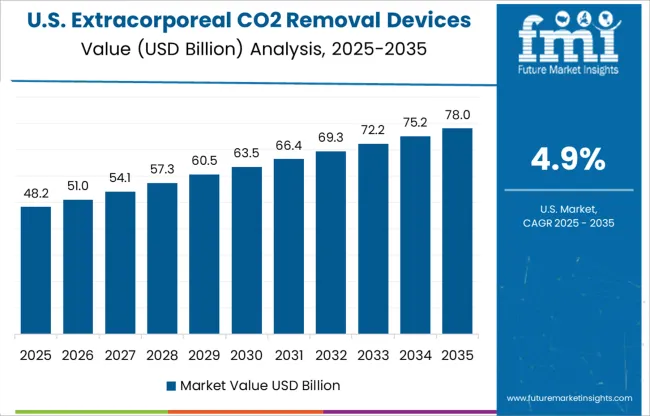
The United States has been a pioneer in the Extracorporeal CO2 Removal Devices Market. In recent years, the utilization of Extracorporeal CO2 Removal Devices in the USA expanded due to a growing emphasis on the removal of carbon dioxide in the healthcare sector. The increase in the number of specialized clinics in the United States has also provided new opportunities for market participants.
The market in the United Kingdom is expected to reach a valuation of USD 201.9 million by 2035. Growing at a CAGR of 6.1% from 2025 to 2035, the market in the country is expected to gross an absolute dollar opportunity of USD 27.5 million.
In Japan, the market is projected to garner an absolute dollar opportunity of USD 3.3 million with a CAGR of 7.1% during the forecast period. The market in the country is expected to reach a valuation of USD 6.7 million by 2035.
The market in South Korea is expected to reach a valuation of USD 114.9 million, growing at a CAGR of 5.7% from 2025 to 2035. The market in the country is expected to witness an absolute dollar opportunity of USD 1.9 million during the forecast period.
Extracorporeal CO2 machines accounted for over half of the total extracorporeal CO2 removal devices demand. The market for Extracorporeal CO2 Machines is expected to grow at a CAGR of 6.2%. Advancements in technical simplification have allowed the usage of additional corporeal CO2 removal equipment to accelerate dramatically, reducing some of the primary difficulties connected to ECMO.
Extracorporeal carbon dioxide removal equipment is theoretically simpler and has comparatively fewer staff needs along with logistical requirements,[mg] as patients may prefer them over ECMO.
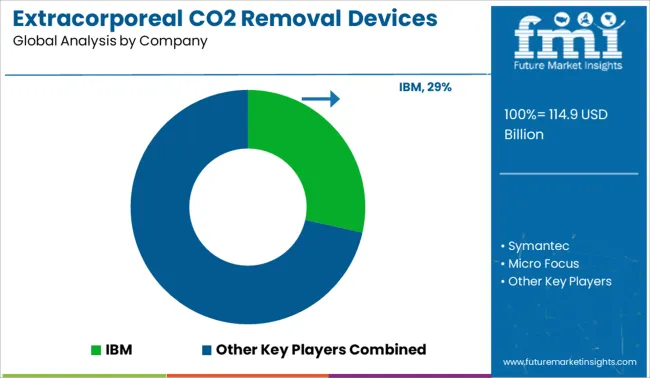
The leading players in the extracorporeal CO2 removal system market have used various methods to boost growth potential in the coming years. Collaborations, alliances, mergers, product approvals, and novel product launches are some of the primary methods used by leading companies to create growth avenues in the market.
Some of the key players operating in the market include Medtronic, Getinge AB, Xenios AG, ALung Technologies, ESTOR S.P.A., Medica Spa, and Aferectica Srl.
Some of the recent developments in the key Extracorporeal CO2 Removal Devices Market are as follows:
Similarly, recent developments related to companies offering Extracorporeal CO2 Removal Devices Market have been tracked by the team at Future Market Insights, which are available in the full report.
The global extracorporeal co2 removal devices market is estimated to be valued at USD 114.9 billion in 2025.
The market size for the extracorporeal co2 removal devices market is projected to reach USD 201.9 billion by 2035.
The extracorporeal co2 removal devices market is expected to grow at a 5.8% CAGR between 2025 and 2035.
The key product types in extracorporeal co2 removal devices market are extracorporeal co2 machines, disposables and other product types.
In terms of application type, acute respiratory distress syndrome (ards) segment to command 48.9% share in the extracorporeal co2 removal devices market in 2025.






Our Research Products

The "Full Research Suite" delivers actionable market intel, deep dives on markets or technologies, so clients act faster, cut risk, and unlock growth.

The Leaderboard benchmarks and ranks top vendors, classifying them as Established Leaders, Leading Challengers, or Disruptors & Challengers.

Locates where complements amplify value and substitutes erode it, forecasting net impact by horizon

We deliver granular, decision-grade intel: market sizing, 5-year forecasts, pricing, adoption, usage, revenue, and operational KPIs—plus competitor tracking, regulation, and value chains—across 60 countries broadly.

Spot the shifts before they hit your P&L. We track inflection points, adoption curves, pricing moves, and ecosystem plays to show where demand is heading, why it is changing, and what to do next across high-growth markets and disruptive tech

Real-time reads of user behavior. We track shifting priorities, perceptions of today’s and next-gen services, and provider experience, then pace how fast tech moves from trial to adoption, blending buyer, consumer, and channel inputs with social signals (#WhySwitch, #UX).

Partner with our analyst team to build a custom report designed around your business priorities. From analysing market trends to assessing competitors or crafting bespoke datasets, we tailor insights to your needs.
Supplier Intelligence
Discovery & Profiling
Capacity & Footprint
Performance & Risk
Compliance & Governance
Commercial Readiness
Who Supplies Whom
Scorecards & Shortlists
Playbooks & Docs
Category Intelligence
Definition & Scope
Demand & Use Cases
Cost Drivers
Market Structure
Supply Chain Map
Trade & Policy
Operating Norms
Deliverables
Buyer Intelligence
Account Basics
Spend & Scope
Procurement Model
Vendor Requirements
Terms & Policies
Entry Strategy
Pain Points & Triggers
Outputs
Pricing Analysis
Benchmarks
Trends
Should-Cost
Indexation
Landed Cost
Commercial Terms
Deliverables
Brand Analysis
Positioning & Value Prop
Share & Presence
Customer Evidence
Go-to-Market
Digital & Reputation
Compliance & Trust
KPIs & Gaps
Outputs
Full Research Suite comprises of:
Market outlook & trends analysis
Interviews & case studies
Strategic recommendations
Vendor profiles & capabilities analysis
5-year forecasts
8 regions and 60+ country-level data splits
Market segment data splits
12 months of continuous data updates
DELIVERED AS:
PDF EXCEL ONLINE
Laser Hair Removal Devices Market Analysis - Growth & Forecast 2025 to 2035
Veno-Venous Extracorporeal Life Support (VV ECLS) Devices Market Size and Share Forecast Outlook 2025 to 2035
Extracorporeal Membrane Oxygenation Machine Market Size and Share Forecast Outlook 2025 to 2035
CO2-based Polycarbonate Polyol Market Size and Share Forecast Outlook 2025 to 2035
CO2 Injector Market Size and Share Forecast Outlook 2025 to 2035
Extracorporeal Membrane Oxygenation Market Size and Share Forecast Outlook 2025 to 2035
Removal Strips Market Size and Share Forecast Outlook 2025 to 2035
CO2 Medical Laser Systems Market Analysis by Application, End User, and Region: Forecast for 2025 to 2035
ETCO2 masks market
Hair Removal Wax Pen Market Size and Share Forecast Outlook 2025 to 2035
Hair Removal Spray Market
FBAR Devices Market
Metal Removal Fluids Market Size and Share Forecast Outlook 2025 to 2035
Snare devices Market
Tattoo Removal Laser Market Size and Share Forecast Outlook 2025 to 2035
C-Arms Devices Market Size and Share Forecast Outlook 2025 to 2035
Timing Devices Market Analysis - Size, Growth, & Forecast Outlook 2025 to 2035
Spinal Devices Market Size and Share Forecast Outlook 2025 to 2035
Earwax Removal Market Analysis by Product, Age Group, Distribution Channel, and Region Forecast Through 2035
Tattoo Removal Patch Market

Thank you!
You will receive an email from our Business Development Manager. Please be sure to check your SPAM/JUNK folder too.
Chat With
MaRIA